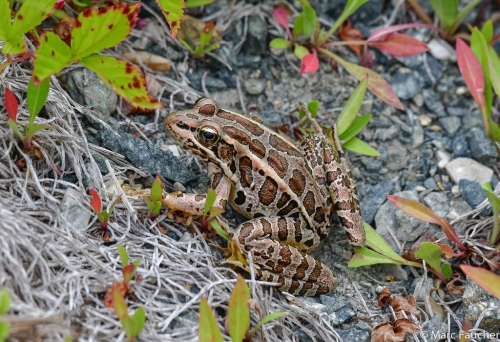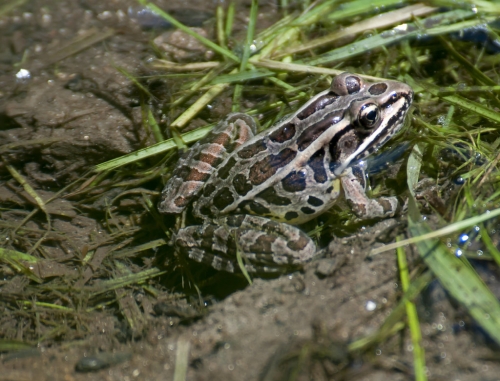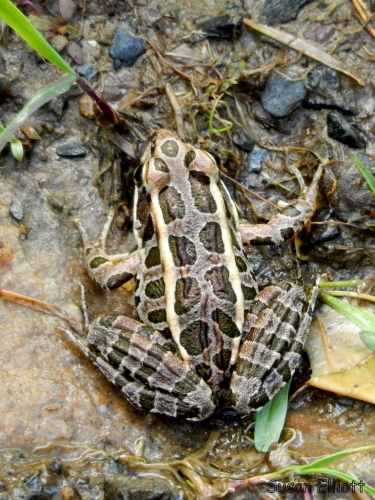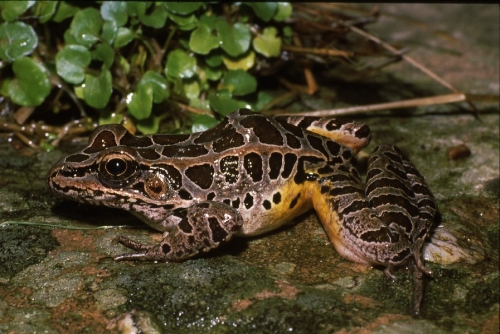Plants and Animals
Lithobates palustris Pickerel frog
Key Characteristics
The Pickerel Frog is a medium to large-sized frog (adult body length 5.1 to 7.6 cm) that is light brown, tan, gray, or olive green in color with two rows of squarish dark brown spots, often outlined in black, running down its back between its light-colored dorsolateral folds. This frog looks similar to the Northern Leopard Frog but can be differentiated by the squarish spots arranged in two rows, as mentioned, and by the bright yellow or orange color present on the groin and undersides of its hind legs (leopard frogs are white in the same area). It has a whitish belly and throat, and a light line along the upper lip. Its breeding call is a low-pitched, snore-like croak similar to the Northern Leopard Frog’s call but the Pickerel Frog’s call is shorter and weaker and lacks the low grunts at the end of the call.
Status and Rank
US Status: No Status/Not Listed
State Status: SC - Special Concern (rare or uncertain; not legally protected)
Global Rank: G5 - Secure
State Rank: S3S4 - Rank is uncertain, ranging from vulnerable to apparently secure
Occurrences
| County | Number of Occurrences | Year Last Observed |
|---|---|---|
| Alcona | 3 | 2023 |
| Allegan | 4 | 2003 |
| Antrim | 1 | 1979 |
| Arenac | 2 | 1998 |
| Baraga | 4 | 2013 |
| Barry | 5 | 2014 |
| Benzie | 3 | 2008 |
| Berrien | 7 | 2017 |
| Calhoun | 6 | 2021 |
| Cass | 3 | 2018 |
| Charlevoix | 4 | 1996 |
| Cheboygan | 2 | 1989 |
| Chippewa | 2 | 2005 |
| Clare | 1 | 1925 |
| Clinton | 1 | 2002 |
| Crawford | 3 | 2021 |
| Delta | 2 | 2018 |
| Eaton | 3 | 2015 |
| Emmet | 3 | 2009 |
| Genesee | 5 | 2015 |
| Gladwin | 1 | 1947 |
| Gogebic | 1 | 1997 |
| Grand Traverse | 5 | 2009 |
| Gratiot | 1 | 2008 |
| Hillsdale | 2 | 2001 |
| Houghton | 3 | 2017 |
| Huron | 4 | 2007 |
| Ingham | 4 | 2018 |
| Ionia | 1 | 2022 |
| Iosco | 4 | 2008 |
| Iron | 4 | 1997 |
| Isabella | 4 | 2009 |
| Jackson | 9 | 2018 |
| Kalamazoo | 8 | 2024 |
| Kalkaska | 7 | 2024 |
| Kent | 7 | 2023 |
| Keweenaw | 1 | 1999 |
| Lake | 3 | 1997 |
| Lapeer | 5 | 2015 |
| Leelanau | 2 | 2005 |
| Lenawee | 3 | 2024 |
| Livingston | 4 | 2003 |
| Luce | 2 | 2008 |
| Mackinac | 1 | 2017 |
| Macomb | 1 | 1996 |
| Manistee | 7 | 2023 |
| Marquette | 5 | 2005 |
| Mason | 6 | 2018 |
| Mecosta | 3 | 2016 |
| Menominee | 4 | 2018 |
| Midland | 1 | 2002 |
| Missaukee | 1 | 2001 |
| Monroe | 4 | 2018 |
| Montcalm | 4 | 2014 |
| Montmorency | 3 | 2009 |
| Muskegon | 3 | 2024 |
| Newaygo | 4 | 2017 |
| Oakland | 11 | 2024 |
| Oceana | 1 | 2013 |
| Osceola | 3 | 2015 |
| Oscoda | 1 | 2021 |
| Otsego | 5 | 2008 |
| Ottawa | 1 | 2018 |
| Roscommon | 3 | 2015 |
| Saginaw | 1 | 2013 |
| Sanilac | 1 | 2004 |
| Schoolcraft | 1 | 2001 |
| St. Clair | 3 | 2018 |
| St. Joseph | 2 | 2017 |
| Tuscola | 2 | 2008 |
| Van Buren | 4 | 2024 |
| Washtenaw | 6 | 2018 |
| Wayne | 2 | 2005 |
| Wexford | 2 | 2016 |
Information is summarized from MNFI's database of rare species and community occurrences. Data may not reflect true distribution since much of the state has not been thoroughly surveyed.
Habitat
Pickerel Frogs occur in a variety of freshwater aquatic and wetland habitats, including fens, bogs, marshes, shrubby/open wet meadows, forested wetlands, ponds, slow-moving streams, springs, and backwater sloughs or swamps. In other parts of its range, this species also has been found in karst topography and caves. The species has been reported to prefer habitats with cool, clear water and avoid areas with polluted or stagnant water. These frogs also seem to prefer the margins of aquatic habitats with dense herbaceous vegetation, such as grassy stream banks and where streams or springs flow into bogs, marshes, or weedy ponds. Upon spring emergence, Pickerel Frogs move to shallow, quiet, warm water for breeding. Breeding habitat includes forested ponds, vernal pools, bog ponds, stream pools, impoundments, and flooded ditches. After breeding, they may migrate to nearby grassy meadows, fields, and open woods, but they tend to not move as far from water as Northern Leopard Frogs. Pickerel Frogs spend the winter buried in the mud or beneath submerged logs or rocks on the bottoms or in the deeper parts of streams, springs, ponds, and bogs.
Natural Community Types
- Bog
- Coastal fen
- Coastal plain marsh
- Dry-mesic northern forest
- Dry-mesic southern forest
- Emergent marsh
- Floodplain forest
- Great lakes marsh
- Hardwood-conifer swamp
- Headwater stream (1st-2nd order), pool
- Headwater stream (1st-2nd order), run
- Lakeplain wet prairie
- Lakeplain wet-mesic prairie
- Mainstem stream (3rd-4th order), pool
- Mesic northern forest
- Mesic prairie
- Mesic southern forest
- Northern fen
- Northern hardwood swamp
- Northern shrub thicket
- Northern wet meadow
- Poor fen
- Prairie fen
- Rich conifer swamp
- Rich tamarack swamp
- Southern hardwood swamp
- Southern shrub-carr
- Southern wet meadow
- Submergent marsh
- Wet prairie
- Wet-mesic prairie
For each species, lists of natural communities were derived from review of the nearly 6,500 element occurrences in the MNFI database, in addition to herbarium label data for some taxa. In most cases, at least one specimen record exists for each listed natural community. For certain taxa, especially poorly collected or extirpated species of prairie and savanna habitats, natural community lists were derived from inferences from collection sites and habitat preferences in immediately adjacent states (particularly Indiana and Illinois). Natural communities are not listed for those species documented only from altered or ruderal habitats in Michigan, especially for taxa that occur in a variety of habitats outside of the state.
Natural communities are not listed in order of frequency of occurrence, but are rather derived from the full set of natural communities, organized by Ecological Group. In many cases, the general habitat descriptions should provide greater clarity and direction to the surveyor. In future versions of the Rare Species Explorer, we hope to incorporate natural community fidelity ranks for each taxon.
Management Recommendations
Maintaining suitable wetland habitats and connectivity among breeding, summer, and overwintering habitats are critical for conservation of extant Pickerel Frog populations. Because this species appears to prefer cool, clear waters and may be intolerant of pollution, avoiding or minimizing activities that result in siltation and runoff of herbicides, insecticides and other chemicals and maintaining natural vegetative buffers around aquatic and wetland habitats would benefit this species. This species also has been found to be susceptible to ranaviruses, a disease that may cause mass mortality, and a “red-leg” disease/bacterial infection. Disinfecting or decontaminating footwear, supplies, and equipment before use in occupied sites can reduce the potential for introducing these and other diseases to populations. Road mortality may be a threat to some populations. Avoiding construction of new roads, closing existing roads, and installing barrier fencing along roads or ecopassages under roads can reduce road mortality where it is an issue. Efforts to obtain information on the species’ current status and distribution, population sizes or abundance, ecology, and site-specific threats and management needs are needed to inform development and implementation of effective management and conservation strategies for this species.
Active Period
Active from first week of April to fourth week of October
Breeding from first week of April to fourth week of May
Survey Methods
Effective methods for surveying this species include breeding call surveys and visual encounter surveys. Breeding call surveys consist of listening for calls of adult males in the evening and at night (i.e., from sunset to 12:00 or 1:00 am) during the breeding season. Breeding and calling generally start as early as April, but can be delayed due to cold weather or start earlier during warmer springs, and extend into May (or early June) in Michigan, especially in the northern part of the state. Call surveys should be conducted on multiple nights during the breeding season and should be conducted during appropriate weather conditions. Humidity and cloud cover are not critical, but a sudden drop in air temperature will cause most frogs to stop calling. Visual encounter surveys can be conducted throughout the active period, especially during the breeding season, during and immediately following rain events, and on humid summer evenings/nights. In the spring, individuals are active during the day and night, but may become more nocturnal in the summer. Visual surveys consist of walking slowly through suitable habitat, overturning cover objects (e.g., logs/woody debris, rocks, etc.), inspecting retreats, and looking for individuals on the surface or under cover. Visual encounter surveys, sampling with a dip net or seine net, and trapping with minnow traps are effective methods for surveying and monitoring egg masses and larvae of this species.
Breeding call surveys
Survey Period: From first week of April to fourth week of May
Time of Day: Evening
Humidity: Humid
Cloud Cover: Overcast
Air Temperature: Above 60 degrees
Precipitation: Rainy
Wind: No Wind
Survey Method Comment: Warm (above 55-65oF), cloudy evenings/nights with little or no wind and high humidity or light rain/drizzle are optimal. Frogs can also be heard during other conditions as well. Avoid surveying on cold, windy nights or during steady or heavy rain.
References
Survey References
- Graeter, G.L., K.A. Buhlmann, L.R. Wilkinson, and J.W. Gibbons (editors). 2013. Inventory and Monitoring: Recommended Techniques for Reptiles and Amphibians. Partners in Amphibian and Reptile Conservation Technical Publication IM-1, Birmingham, AL. 321 pp.
- Heyer, W.R., M.A. Donnelly, R.W. McDiarmid, L.C. Hayek, and M.S. Foster, eds. 1994. Measuring and Monitoring Biological Diversity: Standard Methods for Amphibians. Smithsonian Institution Press, Washington D.C. 364pp.
- Sargent, L.G. 2000. Frog and toad population monitoring in Michigan. The Journal of the Iowa Academy of Science 107(3): 195-199.
Technical References
- AmphibiaWeb. 2020. <http://amphibiaweb.org> University of California, Berkeley, CA. Accessed 18 Mar 2020.
- Arnold, K. 2000. "Lithobates palustris" (On-line), Animal Diversity Web. Accessed March 18, 2020 at https://animaldiversity.org/accounts/Lithobates_palustris/
- Harding, J.H., and D.A. Mifsud. 2017. Amphibians and Reptiles of the Great Lakes Region, Revised Edition. University of Michigan Press, Ann Arbor, MI. 408 pp.
- Hoverman, J.T., M.J.Gray, and D.L. Miller. 2010. Anuran susceptibilities to ranaviruses: role of species identity, exposure route, and a novel virus isolate. Diseases of Aquatic Organisms 89: 97-107.
- NatureServe Explorer 2.0. 2020. <https://explorer.natureserve.org/> NatureServe, Arlington, VA. Accessed 18 Mar 2020.
- Tarter, A., and J.D. Willson. 2020. Pickerel Frog (Rana [Lithobates] palustris). <https://srelherp.uga.edu/anurans/buffow.htm> Savannah River Ecology Laboratory, University of Georgia, Aiken, SC. Accessed 18 Mar 2020.
- Wisconsin Department of Natural Resources. 2015. 2015-2025 Wisconsin Wildlife Action Plan. Madison, WI.





